Design and Simulation of a 19-Electrode MEMS Piezoelectric Thin-Film Micro-Deformable Mirror for Ophthalmology
Abstract
:1. Introduction
2. Structural Design and Optimization of the Deformable Mirror
3. Optimization of Piezoelectric Thin Film Design
4. Optimization of Piezoelectric Thin Film Design
5. Evaluation of Optical Properties of Deformable Mirror
6. Conclusions
Author Contributions
Funding
Data Availability Statement
Conflicts of Interest
References
- Bonora, S.; Jian, Y.; Zhang, P.; Zam, A.; Pugh, E.N., Jr.; Zawadzki, R.J.; Sarunic, M.V. Wavefront correction and high-resolution in vivo OCT imaging with an objective integrated multi-actuator adaptive lens. Opt. Express 2015, 23, 21931–21941. [Google Scholar] [CrossRef]
- Roorda, A.; Romero-Borja, F.; Donnelly Iii, W.; Queener, H.; Hebert, T.; Campbell, M. Adaptive optics scanning laser ophthalmoscopy. Opt. Express 2002, 10, 405–412. [Google Scholar] [CrossRef]
- Lombardo, M.; Serrao, S.; Devaney, N.; Parravano, M.; Lombardo, G. Adaptive Optics Technology for High-Resolution Retinal Imaging. Sensors 2013, 13, 334–366. [Google Scholar] [CrossRef]
- Vacalebre, M.; Frison, R.; Corsaro, C.; Neri, F.; Conoci, S.; Anastasi, E.; Curatolo, M.C.; Fazio, E. Advanced Optical Wavefront Technologies to Improve Patient Quality of Vision and Meet Clinical Requests. Polymers 2022, 14, 5321. [Google Scholar] [CrossRef]
- Kanngiesser, J.; Roth, B. Wavefront Shaping Concepts for Application in Optical Coherence Tomography—A Review. Sensors 2020, 20, 7044. [Google Scholar] [CrossRef]
- Bifano, T.G.; Krishnamoorthy Mali, R.; Dorton, J.K.; Perreault, J.; Vandelli, N.; Horenstein, M.N.; Castanon, D.A. Continuous-membrane surface-micromachined silicon deformable mirror. Opt. Eng. 1997, 36, 1354–1360. [Google Scholar] [CrossRef]
- Bush, K.; German, D.; Klemme, B.; Marrs, A.; Schoen, M. Electrostatic Membrane Deformable Mirror Wavefront Control Systems: Design and Analysis; SPIE: Denver, CO, USA, 2004; Volume 5553. [Google Scholar]
- Bifano, T.; Bierden, P.; Perreault, J. Micromachined Deformable Mirrors for Dynamic Wavefront Control; SPIE: Boulder, CO, USA, 2004; Volume 5553. [Google Scholar]
- Bonora, S.; Poletto, L. Push-pull membrane mirrors for adaptive optics. Opt. Express 2006, 14, 11935–11944. [Google Scholar] [CrossRef]
- Cugat, O.; Basrour, S.; Divoux, C.; Mounaix, P.; Reyne, G. Deformable magnetic mirror for adaptive optics: Technological aspects. Sens. Actuators A Phys. 2001, 89, 1–9. [Google Scholar] [CrossRef]
- Brousseau, D.; Borra, E.F.; Thibault, S. Wavefront correction with a 37-actuator ferrofluid deformable mirror. Opt. Express 2007, 15, 18190–18199. [Google Scholar] [CrossRef] [PubMed]
- Hamelinck, R.; Ellenbroek, R.; Rosielle, N.; Steinbuch, M.; Verhaegen, M.; Doelman, N. Validation of a New Adaptive Deformable Mirror Concept; SPIE: Marseille, France, 2008; Volume 7015. [Google Scholar]
- Gowda, H.G.B.; Wallrabe, U.; Wapler, M.C. Higher order wavefront correction and axial scanning in a single fast and compact piezo-driven adaptive lens. Opt. Express 2023, 31, 23393–23405. [Google Scholar] [CrossRef]
- Sato, T.; Ishida, H.; Ikeda, O. Adaptive PVDF piezoelectric deformable mirror system. Appl. Opt. 1980, 19, 1430–1434. [Google Scholar] [CrossRef] [PubMed]
- Hishinuma, Y.; Yang, E.-H. Piezoelectric unimorph microactuator arrays for single-crystal silicon continuous-membrane deformable mirror. J. Microelectromech. Syst. 2006, 15, 370–379. [Google Scholar] [CrossRef]
- Kanno, I.; Kunisawa, T.; Suzuki, T.; Kotera, H. Development of deformable mirror composed of piezoelectric thin films for adaptive optics. IEEE J. Sel. Top. Quantum Electron. 2007, 13, 155–161. [Google Scholar] [CrossRef]
- Yang, P.; Liu, Y.; Yang, W.; Ao, M.-W.; Hu, S.-J.; Xu, B.; Jiang, W.-H. Adaptive mode optimization of a continuous-wave solid-state laser using an intracavity piezoelectric deformable mirror. Opt. Commun. 2007, 278, 377–381. [Google Scholar] [CrossRef]
- Norton, A.; Evans, J.; Gavel, D.; Dillon, D.; Palmer, D.; Macintosh, B.; Morzinski, K.; Cornelissen, S. Preliminary Characterization of Boston Micromachines’ 4096-Actuator Deformable Mirror; SPIE: Francisco, CA, USA, 2009; Volume 7209. [Google Scholar]
- Verpoort, S.; Wittrock, U. Actuator patterns for unimorph and bimorph deformable mirrors. Appl. Opt. 2010, 49, G37–G46. [Google Scholar] [CrossRef]
- Wlodarczyk, K.L.; Bryce, E.; Schwartz, N.; Strachan, M.; Hutson, D.; Maier, R.R.; Atkinson, D.; Beard, S.; Baillie, T.; Parr-Burman, P.; et al. Scalable stacked array piezoelectric deformable mirror for astronomy and laser processing applications. Rev. Sci. Instrum. 2014, 85, 024502. [Google Scholar] [CrossRef] [PubMed]
- Wang, H. Research on a bimorph piezoelectric deformable mirror for adaptive optics in optical telescope. Opt. Express 2017, 25, 8115–8122. [Google Scholar] [CrossRef] [PubMed]
- Zhu, Z.; Li, Y.; Chen, J.; Ma, J.; Chu, J. Development of a unimorph deformable mirror with water cooling. Opt. Express 2017, 25, 29916–29926. [Google Scholar] [CrossRef] [PubMed]
- Toporovsky, V.; Kudryashov, A.; Skvortsov, A.; Rukosuev, A.; Samarkin, V.; Galaktionov, I. State-of-the-Art Technologies in Piezoelectric Deformable Mirror Design. Photonics 2022, 9, 321. [Google Scholar] [CrossRef]
- Han, X.; Ma, J.; Bao, K.; Cui, Y.; Chu, J. Piezoelectric deformable mirror driven by unimorph actuator arrays on multi-spatial layers. Opt. Express 2023, 31, 13374–13383. [Google Scholar] [CrossRef]
- Ma, J.; Li, B.; Zhang, J.H.; Xu, X.; Chu, J. PZT-thick-film actuators driven by double electrodes for MEMS deformable mirror. Nami Jishu Yu Jingmi Gongcheng/Nanotechnol. Precis. Eng. 2012, 10, 20–23. [Google Scholar]
- Tsuda, S.; Suzuki, T.; Kanno, I.; Kotera, H. High-resolution Piezoelectric Deformable Mirror for Adaptive Optics. In Proceedings of the Conference on Information, Intelligence and Precision Equipment, Online, 17 March 2008. [Google Scholar] [CrossRef]
- Yi, W. Deformable Reflection Micromirror with Piezoelectric Actuation Based on MEMS Process. Micronanoelectron. Technol. 2022, 59, 66–73. [Google Scholar]
- Zhang, Z.; Wu, Z.-Z.; Jiang, X.-X.; Wang, Y.-Y.; Zhu, J.-L.; Li, F. Modeling and experimental verification of surface dynamics of magnetic fluid deformable mirror. Acta Phys. Sin. 2018, 67, 034702. [Google Scholar] [CrossRef]
- Zhu, L.; Sun, P.C.; Bartsch, D.U.; Freeman, W.R.; Fainman, Y. Wave-front generation of Zernike polynomial modes with a micromachined membrane deformable mirror. Appl. Opt. 1999, 38, 6019–6026. [Google Scholar] [CrossRef] [PubMed]
- Dong, W.; Lu, X.; Cui, Y.; Wang, J.; Liu, M. Fabrication and characterization of microcantilever integrated with PZT thin film sensor and actuator. Thin Solid. Films 2007, 515, 8544–8548. [Google Scholar] [CrossRef]
- Chaplya, P.; Carman, G. Compression of PZT-5H Piezoelectric Ceramic at Constant Electric Field: Investigation of Energy Absorption Mechanism; SPIE: San Francisco, CA, USA, 2002; Volume 4699. [Google Scholar]
- Porter, J.; Guirao, A.; Cox, I.G.; Williams, D.R. Monochromatic aberrations of the human eye in a large population. J. Opt. Soc. Am. A Opt. Image Sci. Vis. 2001, 18, 1793–1803. [Google Scholar] [CrossRef] [PubMed]
- Fernández, E.J.; Artal, P. Membrane deformable mirror for adaptive optics: Performance limits in visual optics. Opt. Express 2003, 11, 1056–1069. [Google Scholar] [CrossRef] [PubMed]
- Li, J.; Chen, X. Aberration compensation of laser mode unging a novel intra-cavity adaptive optical system. Optik 2013, 124, 272–275. [Google Scholar] [CrossRef]
- Roddier, F.; Northcott, M.; Graves, J.E. A simple low-order adaptive optics system for near-infrared applications. Publ. Astron. Soc. Pac. 1991, 103, 131. [Google Scholar] [CrossRef]
- Chung, S.-W.; Shin, J.-W.; Kim, Y.-K.; Han, B.-S. Design and fabrication of micromirror supported by electroplated nickel posts. Sens. Actuators A Phys. 1996, 54, 464–467. [Google Scholar] [CrossRef]
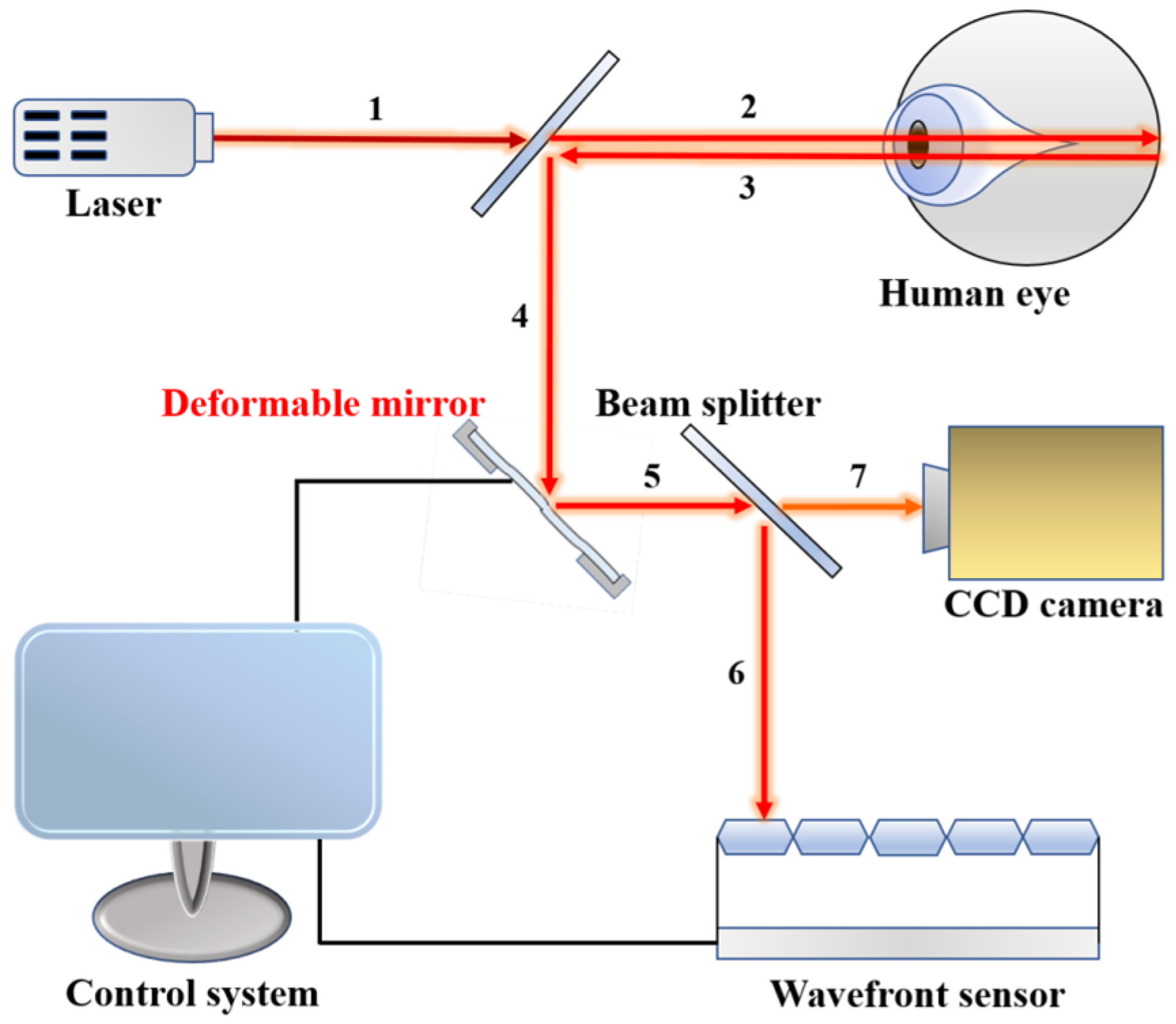

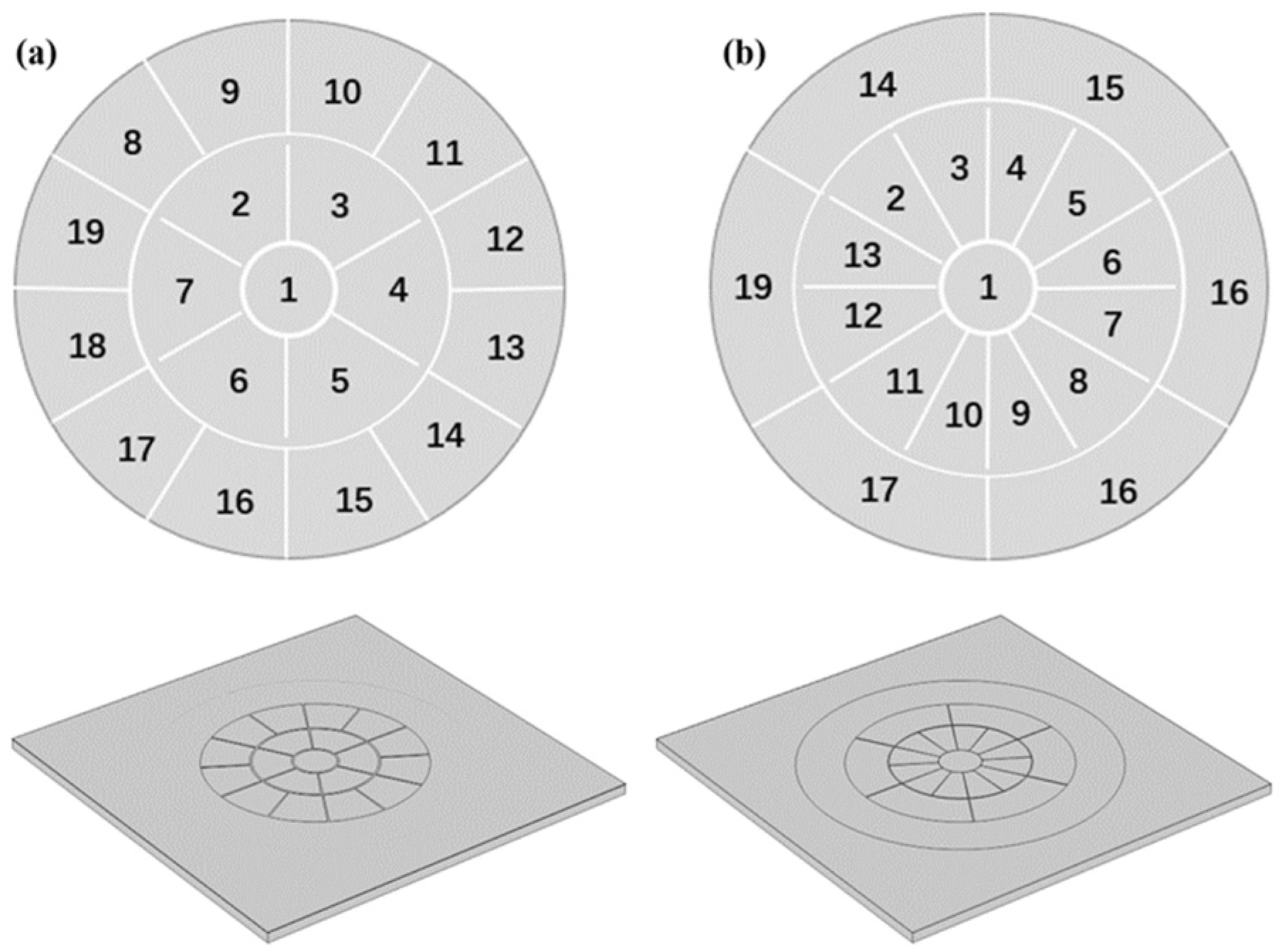

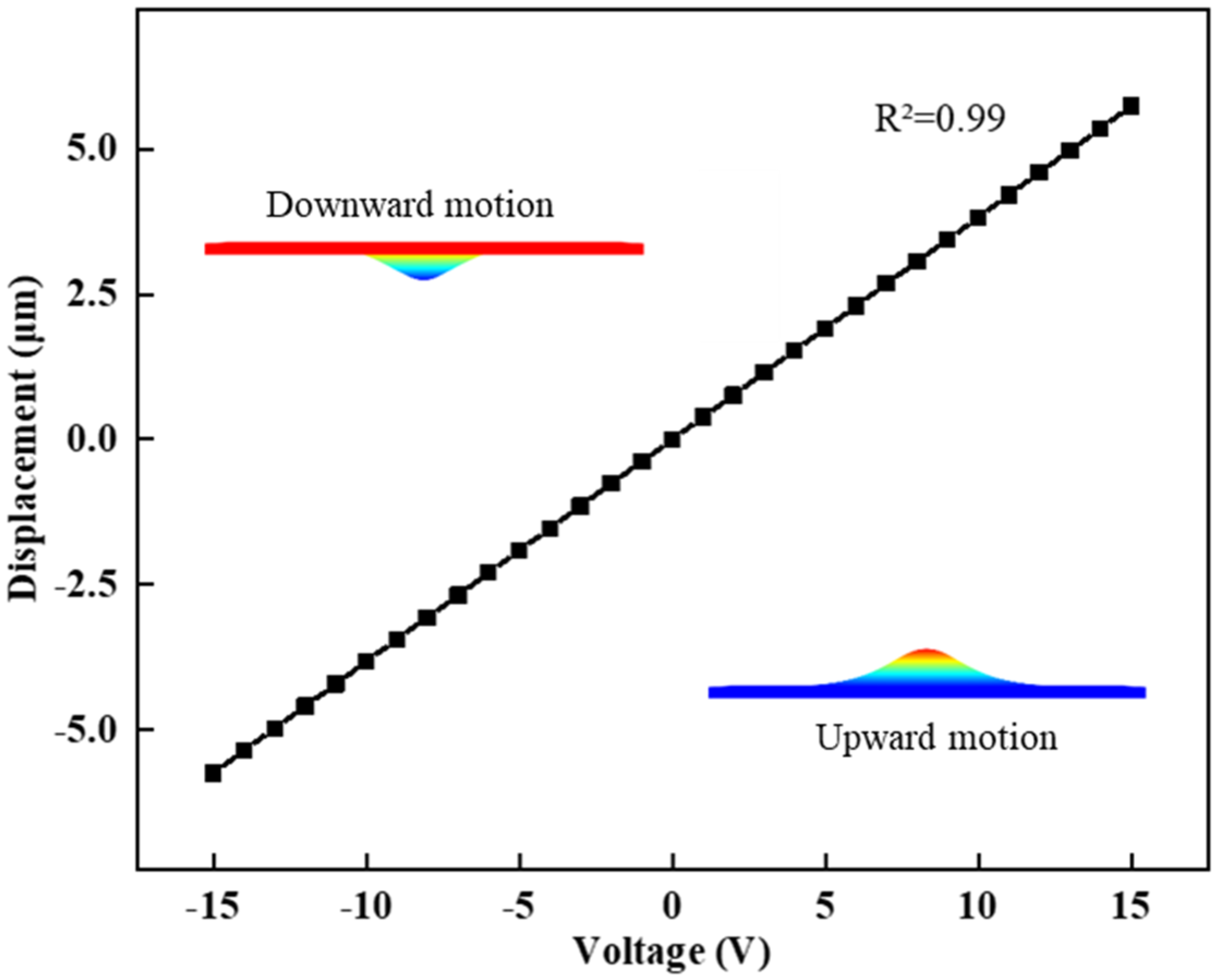
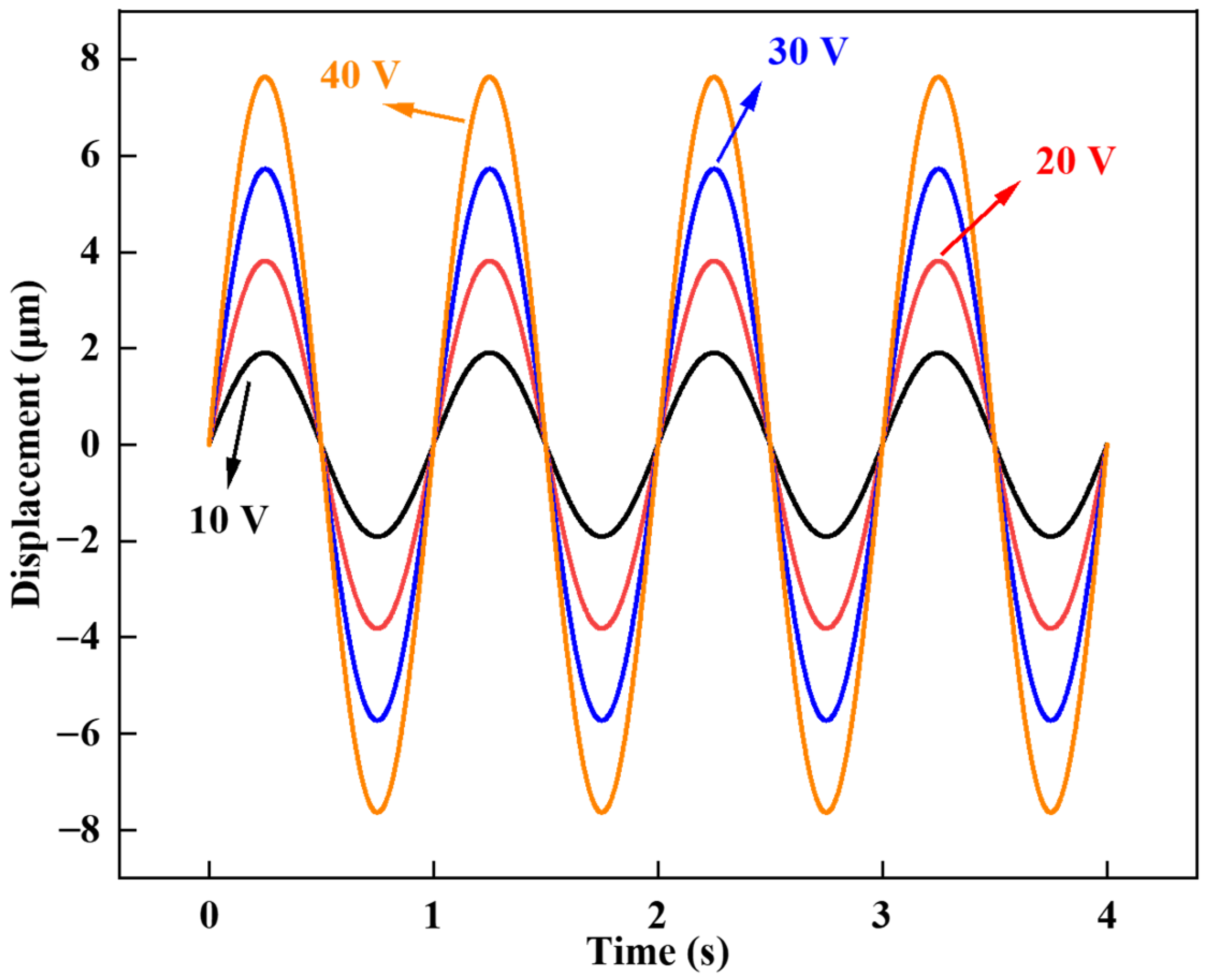

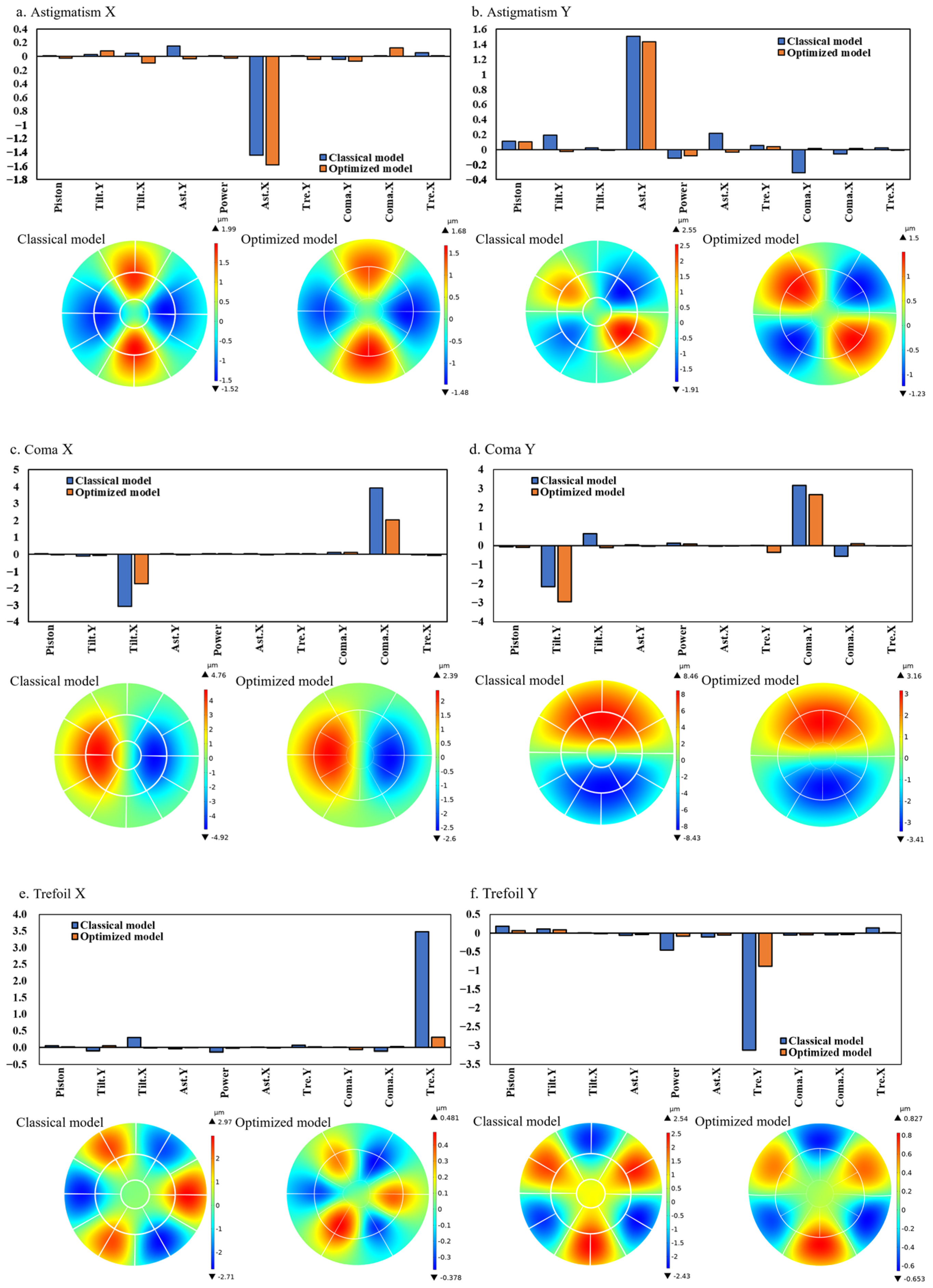


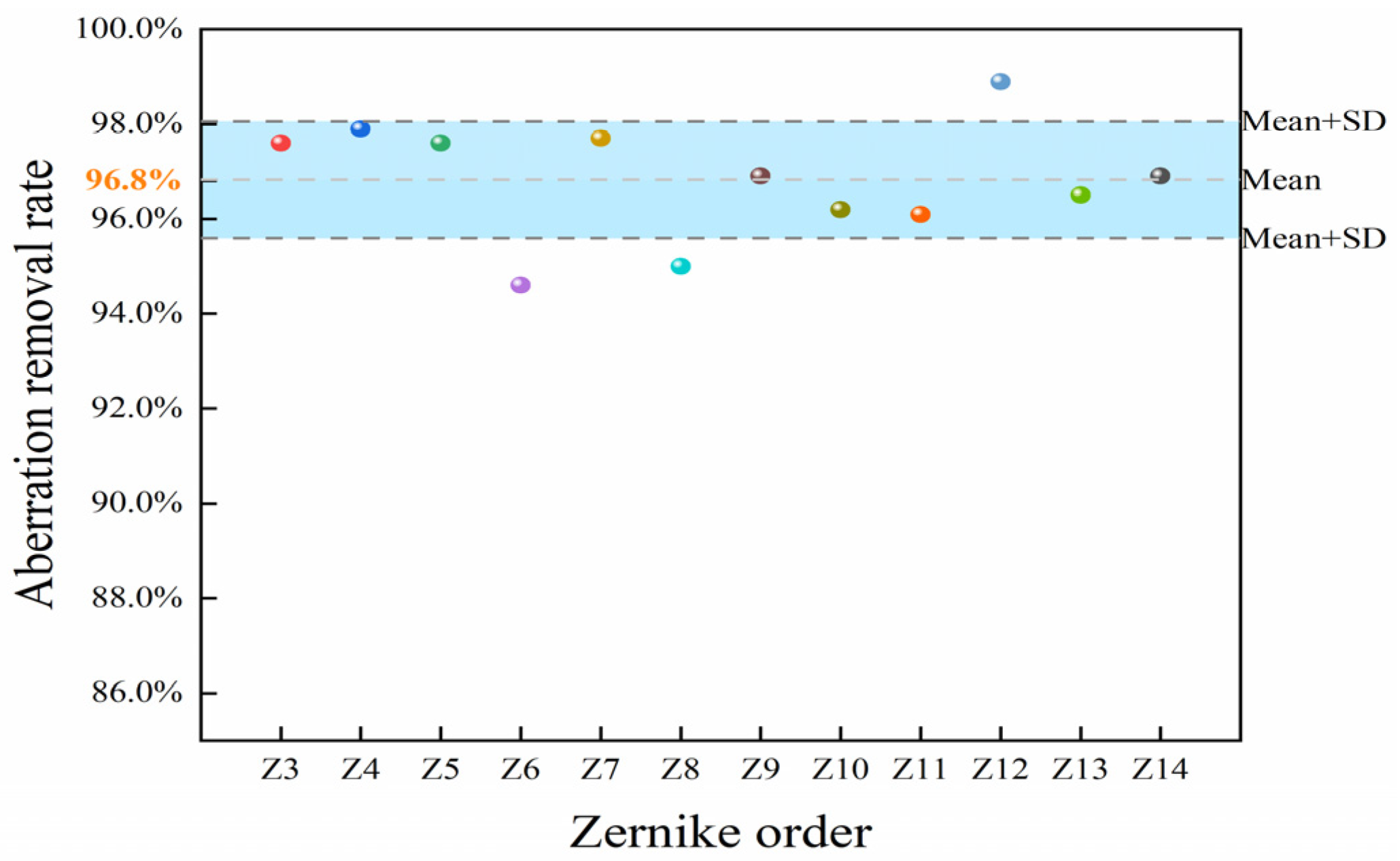
Disclaimer/Publisher’s Note: The statements, opinions and data contained in all publications are solely those of the individual author(s) and contributor(s) and not of MDPI and/or the editor(s). MDPI and/or the editor(s) disclaim responsibility for any injury to people or property resulting from any ideas, methods, instructions or products referred to in the content. |
© 2024 by the authors. Licensee MDPI, Basel, Switzerland. This article is an open access article distributed under the terms and conditions of the Creative Commons Attribution (CC BY) license (https://creativecommons.org/licenses/by/4.0/).
Share and Cite
Hu, Y.; Yin, H.; Li, M.; Bai, T.; He, L.; Hu, Z.; Xia, Y.; Wang, Z. Design and Simulation of a 19-Electrode MEMS Piezoelectric Thin-Film Micro-Deformable Mirror for Ophthalmology. Micromachines 2024, 15, 539. https://doi.org/10.3390/mi15040539
Hu Y, Yin H, Li M, Bai T, He L, Hu Z, Xia Y, Wang Z. Design and Simulation of a 19-Electrode MEMS Piezoelectric Thin-Film Micro-Deformable Mirror for Ophthalmology. Micromachines. 2024; 15(4):539. https://doi.org/10.3390/mi15040539
Chicago/Turabian StyleHu, Yisen, Hongbo Yin, Maoying Li, Tianyu Bai, Liang He, Zhimin Hu, Yuanlin Xia, and Zhuqing Wang. 2024. "Design and Simulation of a 19-Electrode MEMS Piezoelectric Thin-Film Micro-Deformable Mirror for Ophthalmology" Micromachines 15, no. 4: 539. https://doi.org/10.3390/mi15040539




